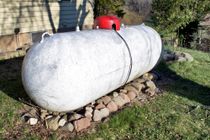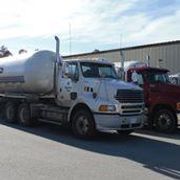Should You Choose an Above-Ground or Underground Propane Tank?

When installing a propane tank, you naturally have to decide where to place it. It can be installed above or under the ground—as long as it’s compliant with local ordinances and EPA standards. Wherever you put it, know that there are pros and cons to each choice. Weigh your options with the following guide, then begin enjoying the environmentally friendly, money-saving advantages of propane.
Factors to Consider
Cost
Though investing in propane as your home’s fuel will pay in the long run no matter where the tank is located, opting for an underground model will cost more. Site excavation and backfilling require extra labor and equipment to accomplish, adding up to more upfront costs. To prevent corrosion and possible groundwater contamination, underground propane tanks need sacrificial anodes and other protective accessories, which are included in overall project costs as well.
Temperature
A buried propane tank is less vulnerable to rapid temperature changes. Because of the earth surrounding it, the tank can stay temperate even in the most extreme weather. An above-ground tank, on the other hand, tends to be affected by outside temperatures, which may impact its performance.
Maintenance
 Whether it’s above or underground, your propane tank requires routine upkeep to prolong its life span. Of the two, an exposed tank doesn’t take much to maintain since it’s easily accessible. A concealed reserve costs more to keep in shape—it needs regular inspections and testing to monitor the effectiveness of its anti-corrosion coating. When it fails, it needs replacement to prevent potential leaks.
Whether it’s above or underground, your propane tank requires routine upkeep to prolong its life span. Of the two, an exposed tank doesn’t take much to maintain since it’s easily accessible. A concealed reserve costs more to keep in shape—it needs regular inspections and testing to monitor the effectiveness of its anti-corrosion coating. When it fails, it needs replacement to prevent potential leaks.
Security & Safety
For properties in high-traffic areas, a visible tank becomes an easy target for vandalism, accidents, and vehicular collisions. It’s also more dangerous when it develops a leak, which can cause fires. None of these issues are present with a hidden, buried tank. Even if a leak occurs, escaped air won’t contaminate nearby water and soil. However, an underground tank may float during a flood, when water levels inside the hole are higher than the fuel level inside. Anchoring the tank to a concrete slab reduces the risk.
How to Choose
Deciding between the two options boils down to your preferences. They both offer the same purpose but with a few advantages of their own. Opt to conceal your propane tank if aesthetics are important to your property or if you have better use of the space it would occupy. But if you’re looking to save on the initial cost, extra maintenance, and floating risk with flooding, go with an above-ground tank instead.
When you need help in deciding where to place your propane tank, ask the professionals at Superior Gas in Piedmont or Roanoke, AL. Providing heat since 1948, they’re the leading supplier of premium quality propane gas—a clean-burning, efficient fuel—throughout the state. Call (256) 396-2428 to schedule a propane delivery today or learn more about their service areas online.
About the Business
(5 reviews)
Have a question? Ask the experts!
Send your question

